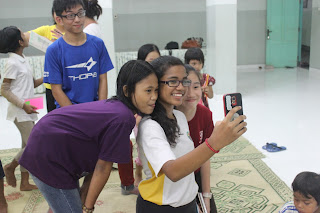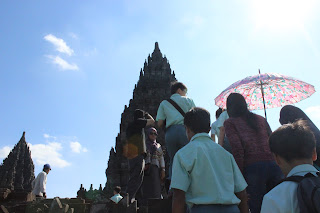Today, we
went to Borobudur Temple, one of the seven wonders of the Asian world. It was
originally 10 floors, which was later reduced to 9 floors due to removal of the
top stoopa. 151 steep steps from the 1st floor to the 9th
floor. It was re-discovered by Sir Stamford Raffles when he was a Javanese
governor. It was built in the 9th century and was left untouched for
800 years when it was buried under ash from Mt Merapi. There are 6 different
types of Buddhist statues that can be found at the temple. They differ from
their hand positions of body positions.
After that
activity we took an hour drive to an orphanage home for our CIP program. We the got a chance to interact and bond with the kids there such as playing games and
giving a small lesson about Singapore. They also performed 2 short performance
for us which we all deeply enjoyed. They also gave us a small tour of their
orphanage and finally, we had a small exchange of gifts and a fun Selfie moment
with them. And towards the end, Our school dedicated an award of appreciation
for hosting us to a Sister in charge of the home and we said our farewells
before leaving. We went to eat dinner later that night and proceeded back to
our hotel where we were debriefed.
 |
| 7th floor of the Borobudur temple |
 |
| Introduction to the orphanage children. Some as young as 5 years old! |
 |
| Orphanage students performing for our arrival. |
 |
| One of the groups giving a brief introduction to Singapore. |
 |
| Orphanage kids participating in games. |
 |
| Group 3 |
 |
| Group 2 |
 |
| Farewell photo. |
 |
| Group 1 |
 |
| Presentation of a plaque for appreciation to the orphanage. |
 |
| Strong ties with the orphanage students formed during this activity, students even shared facebook profiles. |
 |
| Final farewells to the orphanage students before we left for dinner. |






















































